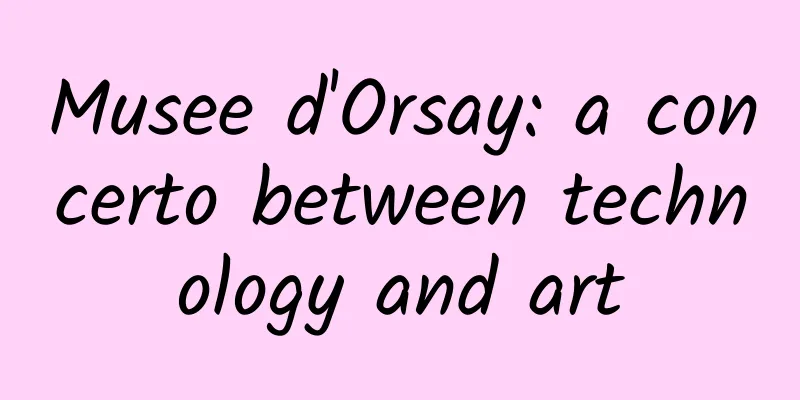Musee d'Orsay: a concerto between technology and art

|
The Musée d'Orsay, which has been open to the public since 1986, is located on the banks of the Seine, across the river from the Louvre and the Tuileries Garden. It is known as one of the three major art museums in Paris along with the Louvre and the Pompidou Center. The Musée d'Orsay has a total of 80 exhibition halls with an exhibition area of 47,000 square meters and a total collection of about 97,000 pieces. The exhibition halls are divided into five floors, displaying art works from 1848 to 1914: the bottom floor is for paintings, sculptures and decorative arts from 1850 to 1870; the middle floor is mainly for paintings and decorative arts from 1870 to 1914; the top floor focuses on the works of artists such as Monet, Manet, Degas, Renoir, Cézanne, Seurat, Gauguin, and Van Gogh. This makes the museum the world's largest collection of Impressionist, Neo-Impressionist and Post-Impressionist works. Technology and Heritage The Orsay Palace was a Napoleonic building that was destroyed in 1871. After that, French architects Emile Bernard, Victor Laloux and Lucien Magne designed the Gare d'Orsay on the site of the old Palace. The exterior of the station adopts a classical aesthetic design, while the interior uses the most advanced technologies of the time, such as elevators, escalators and luggage ramps. In 1900, when the Paris World Expo was held, this advanced building was officially opened. For nearly 40 years, the Gare d'Orsay served as the terminus of the railway in southwestern France. It was not until 1939 that the station ceased operations because the platform was too short to accommodate longer trains. In 1977, the government decided to convert it into a museum. The architectural firm redesigned it according to new functional requirements while respecting the original architectural style. As a result, the Musée d'Orsay retains the iconic appearance of the station, such as the glass roof, vaulted hall and huge clock, and officially opened in 1986. Optics and Color In the second half of the 19th century, science and technology continued to develop, and the invention of photography had a great impact on painting art. At that time, optics developed rapidly, and people knew that color mainly comes from light, and the difference in color is mainly caused by the different frequencies of light waves. Thanks to these studies, artists knew that the source of color is not indoors, but outdoors, and thus discovered more color laws through sketching in the sun. Under the influence of scientific and technological progress, a group of young painters represented by Claude Monet combined light and color, constantly observed the visual effects of light and shadow outdoors, and created a subversive "visual reality". They were later called "Impressionists". The Neo-Impressionists, who came later, added more scientific analysis to this foundation and advocated the use of optical color mixing instead of pigment color mixing, among which Georges Seurat was the best. Seurat absorbed the research results of chemist Michel Eugène Chevreul on color contrast and the inherent color of objects, and rigorously and systematically juxtaposed color dots to simulate the instantaneous light and color sensation of the retina. Modern color printing is derived from this "pointillism" principle. In addition, he also made precise mathematical calculations on the proportion, size, shape, angle and other factors in the picture to complete the composition of the picture. Weather and the "London Fog" William Turner, a British painter, was the first painter to use "weather" as the theme. In his painting "Rain, Steam and Speed - Great Western Railway", he used freehand brushwork and hazy colors to depict the majestic momentum of a steam locomotive running in the rain. There are almost no clear outlines or lines in the whole painting, thus creating a strange modern aesthetic. Monet's series of paintings, "The Houses of Parliament in London: Sunlight in the Fog", now in the collection of the Musée d'Orsay, is regarded as a challenge to Turner by Monet. Unlike Turner's blurred and clear brushstrokes, Monet's brushstrokes appear particularly rough at close range. His brushstrokes are obvious, the paint is drier, and the color is casual. It is difficult to recognize at a close look, but you can see it at a distance. These fragmented and primitive brushstrokes seem to be endowed with vitality, and they keep moving and flickering on the viewer's retina. Monet captured the fragmented moments in life and guided the audience's eyes to complete the final finishing touch of the work. In addition to the artistic beauty, the series of paintings "Houses of Parliament in London: Sunlight in the Fog" also provides indirect evidence for scientists to study the air composition of London in the 19th century. The fog in the painting is not the familiar white color, but purple-red. Monet lived in the era when the European Industrial Revolution was in full swing. Coal was used in large quantities as a fuel, and its combustion would form smoke and sulfide particles. Sulfide is yellow, coal tar is dark brown, and aniline and phenol compounds in coal tar form red and blue, which is the cause of the purple-red London fog in Monet's eyes. Science and art learn from each other and provide support for their respective development. The rich collections of the Musee d'Orsay not only record the great changes in art, but also bear witness to the great achievements made by science and art together. [The author is a science and technology counselor at the Ancient Science and Technology Exhibition Department (in preparation) of the China Science and Technology Museum] |
>>: Are you anxious about your body shape?
Recommend
Can we follow the trend of using AI to fill in college applications?
Free volunteer application software, proven to be...
E-commerce private domain traffic diversion guide!
What exactly is private domain? The author of thi...
How much does a customized mini program cost? How much does it cost to customize a small program on the market?
How much does a customized mini program cost? How...
How can copywriting capture users?
The world is so busy, no one will waste one more ...
These Android apps may stop working in 2022
ARM held the DevSummit Developer Summit. At the m...
I never thought that there is "third-hand smoke" after second-hand smoke? !
"Smoking is harmful to health" has beco...
Many people have never cleaned this "bacteria nest" in the kitchen! Check it yourself
When we use a microwave to heat food at home, in ...
How much does it cost to customize the Yangquan Gardening Mini Program? Yangquan Gardening Mini Program Customized Price Inquiry
WeChat Mini Program is an application that users ...
A table to solve the eating problem of "high blood sugar patients"
At the beginning, please do two multiple-choice q...
The most detailed tutorial on how to maintain a Douyin account
Everyone who makes short videos knows about Douyi...
After iOS 15.2 was released: Apple Watch users in China are looking forward to the ECG function being launched soon
[[440224]] If you are an Apple Watch user, then y...
Tesla's new promotional method: It turns out that cars can be sold like this
Beijing time, July 30 morning news, Tesla announc...
Brand Communication Perspectives for 2022
As long as it involves business, there will be ma...
How to let content operations penetrate products and drive rapid product growth
"Content" in a broad sense includes mus...
Is it true that setting off fireworks can disinfect? Experts: The cost outweighs the gain
As the Spring Festival approaches, the discussion...









